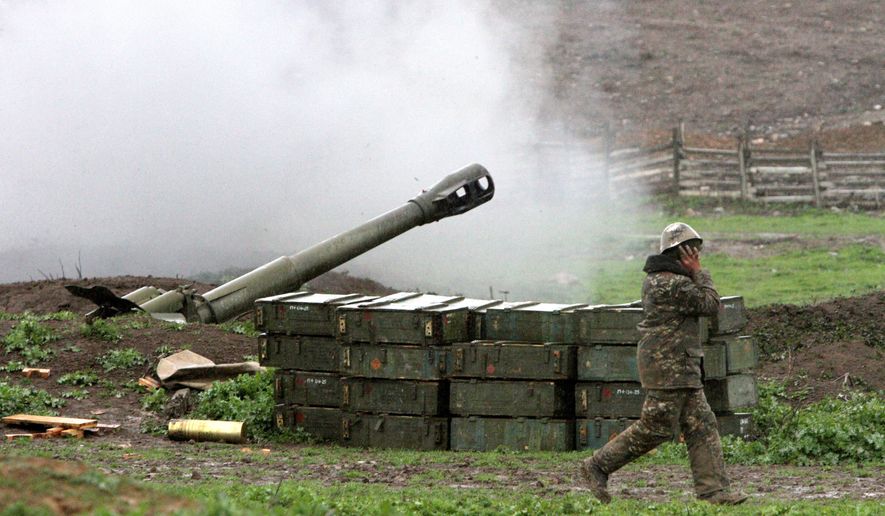Clashes flared across the delicate frontline between Azerbaijani and Armenian forces Sunday, even after Azerbaijan attempted to declare a cease-fire in hopes of halting an outbreak of violence that has killed more than 30 soldiers and wounded scores of others since Saturday.
The worst outbreak in fighting in more than 20 years over the disputed Nagorno-Karabakh territory, which sits between the two former Soviet republics, has sent nerves on edge from Europe to Washington, where concerns are high that Russian and Turkish meddling in the region may have sparked the new wave of hostilities.
The separatist Nagorno-Karabakh territory of Azerbaijan has been under the control of Armenia’s military and local ethnic Armenians since the Azerbaijani and Armenian militaries waged a war over the territory that claimed some 30,000 lives following the breakup of the Soviet Union.
The war has been frozen since 1994, when both sides agreed to a cease-fire. However, a series of small clashes has caused tensions to rise during recent years, with the situation hitting a boiling point on Saturday.
Fierce clashes left at least 18 Armenian and 12 Azerbaijani soldiers dead after the two sides accused each other of attacking with heavy weaponry across the volatile frontline. Authorities in Nagorno-Karabakh said one boy was killed in the fighting, while Azerbaijan said one of its helicopters had been shot down and that two Azerbaijani civilians had died, with 10 others wounded.
After claiming that its forces had taken control of several strategic areas inside Armenian-controlled territory, Azerbaijani officials appeared to be bowing to international calls for calm by declaring a unilateral cease-fire on Sunday morning.
But clashes continued to rumble across the frontline through Sunday afternoon, with both sides blaming each other for attacks. A spokesman for Azerbaijan’s defense ministry told Agence France-Presse that “the Armenians have continued shelling throughout the day, without interruption.”
An Armenian defense ministry spokesman countered that “fighting with the use of tanks and artillery continues as Azerbaijan is telling lies that it halted hostilities. Azerbaijan continues shelling both Karabakh army positions and Armenian villages.”
Calls for calm
In Washington, Secretary of State John F. Kerry called on both sides to “show restraint” and enter into immediate talks toward restoring the 1994 cease-fire — an agreement that was originally co-chaired by the U.S., France and Russia via the Organization for Security and Cooperation in Europe.
Despite the cease-fire, the two sides have never signed a peace deal.
Energy-rich Azerbaijan is backed by Turkey and has often had annual military expenditures in excess of Armenia’s entire state budget. Over the years, Azerbaijani officials have threatened to seize Nagorno-Karabakh back by force if negotiations failed to yield results.
But Russia-backed Armenia has said it could crush any offensive.
The last serious flare-up came in November 2014, when Azerbaijan shot down an Armenian military helicopter.
In a statement on Sunday, Mr. Kerry stressed that “there is no military solution to the conflict” and vowed that U.S. officials are “firmly committed to working with the sides to reach a lasting and negotiated peace.”
While Russian officials joined with Washington in calling for an immediate halt, analysts say Moscow’s posture toward the situation is complex and that its recent military muscle flexing in the region my have triggered the current clashes.
A Russia-Turkey clash?
In interviews with The Washington Times last month, several analysts specifically warned that a Nagorno-Karabakh meltdown could occur as a result of surging tensions between Russia and Turkey.
The frozen conflict has for decades been a bone of contention between the two.
Ankara has long sided with the Azerbaijani government, imposing a dual trade embargo on Armenia, while Moscow has sought to exert influence across the board by selling weapons to both the Armenians and the Azerbaijanis.
But Russian President Vladimir Putin’s appears to have been engaged in a new calculus since last November when Turkey shot down a Russian fighter jet that had veered into Turkish airspace from Syria.
The months since have seen Moscow beef up its military footprint inside Armenia, a country of roughly 3 million people that shares a 165-mile border and a land-mine-filled history with Turkey.
After quietly signing an air defense agreement with the Armenia in December, Moscow deployed at least four new MiG-29 fighter jets, along with a slew of other military vehicles to a Russian base just outside the Armenian capital of Yerevan.
Some analysts saw the moves as part of push by Mr. Putin to use Armenia to send a message to the Turks.
Ariel Cohen, a senior fellow at the Atlantic Council in Washington, told The Times last month that with Turkish-Russian relations “in a death spiral, [Armenia] has become a front-line state in the context of that confrontation.”
“The biggest explosive potential here is not vis-a-vis Turkey; it’s vis-a-vis Azerbaijan and Nagorno-Karabakh,” Mr. Cohen said. “That’s the main powder keg in that part of the world.”
At the time, Justin Burke, the managing editor at EurasiaNet, agreed that “Karabakh is intertwined in all of this.”
“With the frozen Karabakh conflict, and now the Russia-Turkey tensions, there are just a whole lot of people playing with matches in the region and sometimes fires begin accidentally,” Mr. Burke told The Times in early-March.
Armenia’s relationship with Turkey, meanwhile, has been shadowed by Armenian charges that the Turks engaged in a genocide against its ethnic Armenian minority during World War I.
For its part, Turkey stood steadfastly behind Azerbaijan over the weekend, with Turkish President Recep Tayyip Erdogan vowed to support the Azerbaijanis “to the end” in the conflict.
“We pray our Azerbaijani brothers will prevail in these clashes with the least casualties,” Mr. Erdogan said.
• This article is based in part on wire service reports.
• Guy Taylor can be reached at gtaylor@washingtontimes.com.




Please read our comment policy before commenting.